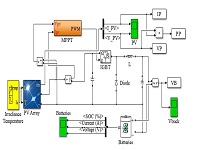Photovoltaic Power Control Using Fuzzy Logic and Fuzzy Logic Type 2 MPPT Algorithms and Buck Converter
Keywords:
photovoltaic panel, fuzzy logic, fuzzy logic type 2, matlab/simulinkAbstract
This work presents the analysis, design, simulation and hardware implementation of the classical Fuzzy Logic (FL) and the proposed Fuzzy Logic Type 2 (FLT2) MPPT techniques for standalone PV System. FL and FLT2 MPPT algorithms are simulated via MATLAB/ Simulink and implemented via LabVIEW software and CompactRio hardware, in different climatic conditions. Also, they are compared to the Incremental Conductance (InC) MPPT algorithm, one of the most common used MPPT techniques. The studied system consists of PV array, DC/DC converter, MPPT controller, batteries and load. The PV array is connected to the DC / DC buck converter that works based on the output pulses of the MPPT controller to make the PV system operates at the Maximum Power Point (MPP). Thereafter, based on the simulations and the experimental results, a comparison is made to be useful for MPPT designers and researchers in this area.

Published
How to Cite
Issue
Section
License
Submission of a manuscript implies: that the work described has not been published before that it is not under consideration for publication elsewhere; that if and when the manuscript is accepted for publication. Authors can retain copyright in their articles with no restrictions. is accepted for publication. Authors can retain copyright of their article with no restrictions.
Since Jan. 01, 2019, AITI will publish new articles with Creative Commons Attribution Non-Commercial License, under The Creative Commons Attribution Non-Commercial 4.0 International (CC BY-NC 4.0) License.
The Creative Commons Attribution Non-Commercial (CC-BY-NC) License permits use, distribution and reproduction in any medium, provided the original work is properly cited and is not used for commercial purposes.



